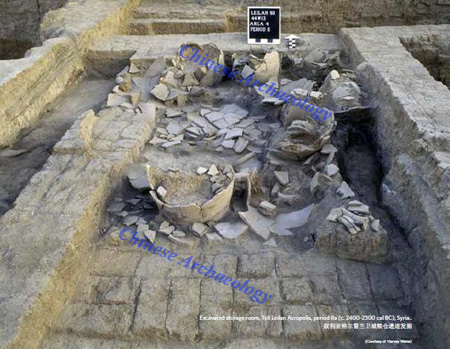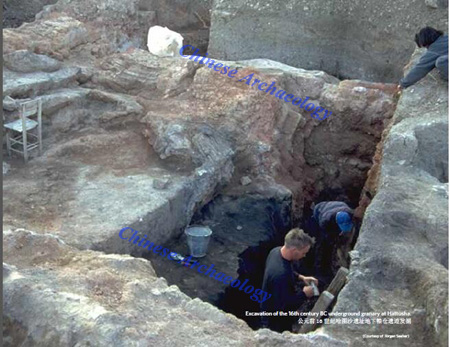From First Farmers to First Cities: New Insights into the Agricultural Origins of Urban Societies in Western Eurasia
From:Chinese Archaeology NetWriter:Amy BogaardDate:2015-12-28
Archaeologists working in different parts of the world have charted the emergence of ‘cities’, featuring radical wealth inequality, central institutions such as palaces or temples and large concentrations of people. These urban societies share an agricultural economy, suggesting that farming enabled increases in community scale, inequality and centralization. Classic accounts of this process have identified agricultural intensification – increasing inputs of labour and hence yields per unit area of land – as a primary cause (and consequence) of urbanization. According to this perspective, new technologies such as large-scale irrigation (in arid regions) or the ox-drawn ard plough arose to support emerging elites and urban centres, contrasting with earlier forms of ‘extensive’, low-input and transient cultivation. These models assume an evolutionary progression from low- to high-input agrosystems, with emerging elites as the architects of newly ‘intensive’ arable landscapes. They also suggest that earlier farming practice made little contribution to the formation of later urban systems, or to the emergence of lasting social inequality. Importantly, influential models of agricultural ‘intensification’ – from Ester Boserup’ssequence of shortening fallow periods, to Andrew Sherratt’s idea of a ‘secondary products revolution’ in urbanizing western Eurasia – were formulated before there was much direct evidence for the nature of early farming practice and its development through later prehistory.The collaborative research reported here focuses on the most direct evidence of agriculture available: the charred remains of crops and their weed flora, harvested and transported from arable fields, and deposited on archaeological sites in crop storage facilities, or as the by-products of crop processing. The study of this material falls within a subdiscipline of archaeology called archaeobotany. By applying and integrating new analytical techniques to this material, we can now build a ‘bottom-up’ account of farming practice, beginning with the growing conditions and fields of individual households and settlements, to investigate the role of agriculture through regional sequences of social change, including the emergence of some of the world’s earliest urban centres.

Excavated storage room, Tell Leilan Acropolis, period IIa (c. 2400-2300 cal BC), Syria..
We use crop stable isotope values and functional weed ecology to build ecological models of contrasting farming systems that can be observed today. In particular, we have characterized the weed flora and crop isotope values associated with highly labour-intensive management (high soil productivity and disturbance) versus low-intensity conditions (low soil productivity and disturbance). By conducting surveys of modern weed flora and crops growing in ‘traditional’ agricultural regimes in (semi-)arid regions such as southern Morocco, and in regions of temperate Europe including Haute Provence, France and Asturias, Spain, we have the opportunity to characterize and compare spectra of agricultural intensity in different climate zones. These ecological models of high- and low-input farming systems enable us to frame expectations for what ‘intensification’ – increasing inputs of labour and resources per unit area – should look like in terms of crop stable isotope values and weed ecology.
Application of these methods and models to the archaeobotanical data has yielded results that pose a clear challenge to evolutionary models of intensification. A key inference is that early farming in diverse regions of western Eurasia was not of an ‘extensive’, low-input or transient type. Rather, early established farming tended to involve significant inputs of labour to create high-yielding, relatively easily worked plots that could be farmed for many generations, and were likely subject to ownership and inheritance claims by the households that maintained them. This broad inference is based on two kinds of data: crop stable isotope values indicative of manuring and (in drier regions) preferential watering of certain crops; and ecological profiling of early arable weed assemblages, which reflect relatively high-input, ‘intensive’ management, with careful tillage and weeding as well as manuring and (where needed) watering. Our results have also highlighted the likelihood of autumn-sowing of early cereals, not only in western Asia but also in temperate Europe, underlining the importance of high yields (facilitated by a longer growing season than in springsown crops).

Excavation of the 16th century BC underground granary at Hattusha
Our analysis of the data from other regions is ongoing, but several emerging trends can be noted. First, soil productivity and disturbance – and likely crop yields per unit area – often decreased through time, overturning the expectations of th ‘intensification’ hypothesis. Secondly, however, Neolithic farming regimes were already complex systems that could incorporate both ‘high-input’ and ‘low-input’ crops: early farmers were forced to make strategic decisions about use of (limited) manure, water and other resources, as well as limited labour availability. Thirdly, agricultural strategies among households and settlements became if anything increasingly divergent through time, in part because crop spectra became more diverse.
Archaeobotanist Martin Jones dubbed this diversification phenomenon ‘food globalization in prehistory’: a process of longdistance crop exchanges that resulted, for example, in the transfer of east Asian millets to Europe during the Bronze Age. As a wider repertoire of crops came into play in western Eurasia, access to animal traction for ploughing and transport played an increasingly crucial role, enabling farmers to expand the continuum of agricultural intensity further than before.
In some of our case studies, it is apparent that crops stored in elite/institutional contexts reflect particularly ‘extensive’, likely elite-sponsored cultivation: large-scale production, dependent on specialized plough animals and access to a large labour pool to take in the harvest. The enormous underground ‘granary’ complex at the Hittite capital of Hattusha, in central Anatolia, perhaps represents the most impressive instance of state mobilization of crops included in our work: its excavator, Jurgen Seeher of the German Archaeological Institute in Istanbul, has estimated that at full capacity the 32 chambers of this 118-metre-long structure would hold enough cereal grain to feed 20,000-30,000 people for a year. But in many other cases, our Bronze(-Iron) Age data continue to reflect the diversified and risk-averse agricultural strategies of households, including elite and commoners alike. Rather than attributing the potential and sustainability of urbanisation to elitesponsored innovations and interventions in farming, therefore, our ‘bottom-up’ view of long-term farming development in western Eurasia suggests something quite different: that the practices of small-scale farmers, from the Neolithic onwards, ultimately underwrote large-scale nucleation and social stratification. Our work on the long-term agroecology of societies, from first farmers to first cities, indicates that it was the social mechanisms of surplus mobilization that were decisive for the rise of more unequal societies and centralizing institutions, and not a simple,evolutionary step-change in farming practice or intensity.
The work described here is collaborative and has been conducted through two consecutive projects: ‘Crop stable isotope ratios: new approaches to palaeodietary and agricultural reconstruction’ (PI Bogaard; co-Investigators: Michael Charles, Richard Evershed, Tim Heaton, Glynis Jones), funded by the Natural Environment Research Council (UK) (NE/E003761/1); and an ongoing project, ‘The agricultural origins of urban civilization (www.agricurb.com), funded by the European Research Council (No. 312785; PI Bogaard). The latter team features post-doctoral researchers Valasia Isaakidou, Erika Nitsch and Amy Styring, as well as doctoral students Charlotte Diffey, Laura Green, Elizabeth Stroud and Petra Vaiglova. We gratefully acknowledge the collaboration and contribution of many scholars in this project (http://agricurb. com/people/).
Amy Bogaard and Amy Styring
Amy Bogaard earned her PhD in Archaeology from the University of Sheffield in 2002. She has worked as an archaeobotanist/archaeologist in Turkey, Greece and Germany. Her publications include Early Farming in Central Europe (2004, Routledge), Plant Use and Crop Husbandry in an Early Neolithic Village: Vaihingen an der Enz, Baden-Württemberg (2011, Habelt) and Crop manuring and intensive land management by Europe's first farmers (PNAS 110: 12589-12594). She is currently leading the ‘Agricultural Origins of Urban Civilization’ project at the University of Oxford, funded by the European Research Council. Amy Styring is an archaeological chemist with a specialism in crop isotope geochemistry and a long-standing research interest in ancient agriculture, human-environment interactions and adaptation to societal and environmental changes. She earned her PhD on ‘Crop Amino Acid δ15N Value Expression in Bone Collagen of Ancient Fauna and Humans: A New Approach to Palaeodietary and Agricultural Reconstruction’ from the University of Bristol in 2012. She is currently a postdoctoral research assistant on the ‘Agricultural Origins of Urban Civilization’ project at the University of Oxford.
(Amy Bogaard Amy Styring University of Oxford)
(Source: Research Center for World Archaeology, Shanghai Academy)

